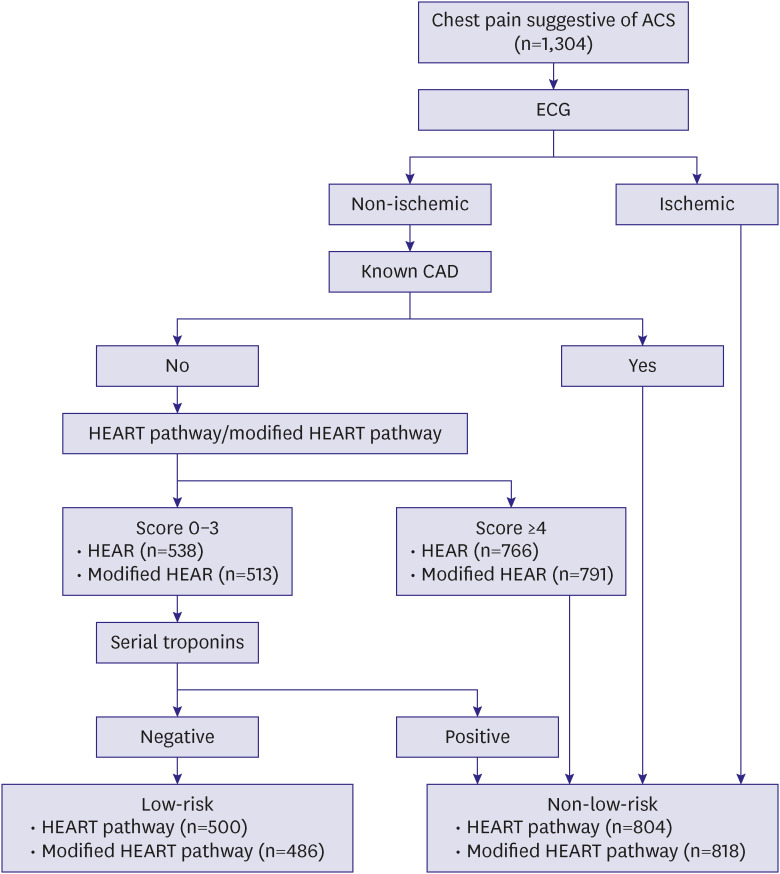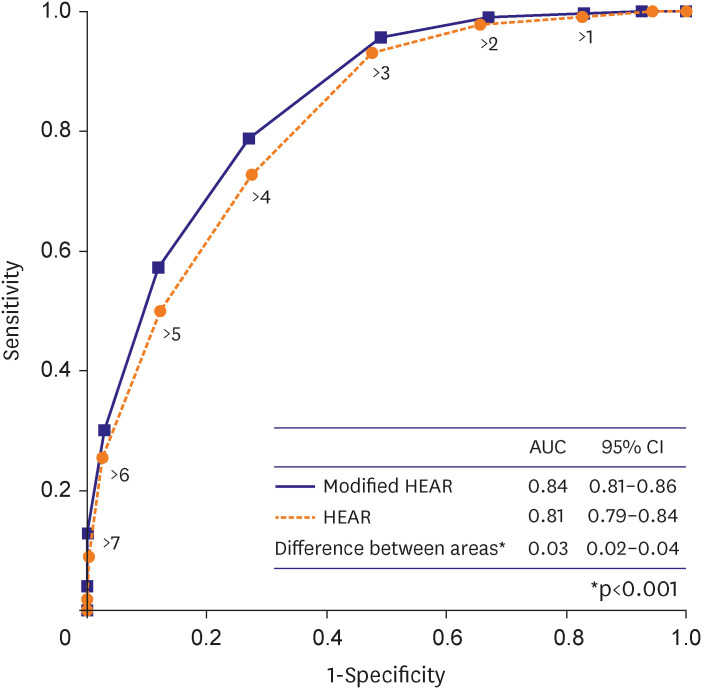Korean Circ J.
2023 Sep;53(9):635-644. 10.4070/kcj.2022.0354.
Modification of HEART Pathway for Patients With Chest Pain: A Korean Perspective
- Affiliations
-
- 1Department of Emergency Medicine, Asan Medical Center, University of Ulsan College of Medicine, Seoul, Korea
- KMID: 2545958
- DOI: http://doi.org/10.4070/kcj.2022.0354
Abstract
- Background and Objectives
The History, Electrocardiography, Age, Risk factors, and Troponin (HEART) pathway was developed to identify patients at low risk of a major adverse cardiac event (MACE) among patients presenting with chest pain to the emergency department.
Methods
We modified the HEART pathway by replacing the Korean cut-off of 25 kg/m2 with the conventional threshold of 30 kg/m2 in the definition of obesity among risk factors. The primary outcome was a MACE within 30 days, which included acute myocardial infarction, primary coronary intervention, coronary artery bypass grafting, and all-cause death.
Results
Of the 1,304 patients prospectively enrolled, MACE occurred in 320 (24.5%). The modified HEART pathway identified 37.3% of patients as low-risk compared with 38.3% using the HEART pathway. Of the 500 patients classified as low-risk with HEART pathway, 8 (1.6%) experienced MACE, and of the 486 low-risk patients with modified HEART pathway, 4 (0.8%) experienced MACE. The modified HEART pathway had a sensitivity of 98.8%, a negative predictive value (NPV) of 99.2%, a specificity of 49.0%, and a positive predictive value (PPV) of 38.6%, compared with the original HEART pathway, with a sensitivity of 97.5%, a NPV of 98.4%, a specificity of 50.0%, and a PPV of 38.8%.
Conclusions
When applied to Korean population, modified HEART pathway could identify patients safe for early discharge more accurately by using body mass index cut-off levels suggested for Koreans.
Keyword
Figure
Cited by 1 articles
-
Adapting the HEART Pathway for Korean Patients: The Potential Impact on Chest Pain Management at Emergency Department
Hack-Lyoung Kim
Korean Circ J. 2023;53(9):645-647. doi: 10.4070/kcj.2023.0165.
Reference
-
1. McCarthy BD, Beshansky JR, D’Agostino RB, Selker HP. Missed diagnoses of acute myocardial infarction in the emergency department: results from a multicenter study. Ann Emerg Med. 1993; 22:579–582. PMID: 8442548.
Article2. Peacock WF, Maisel AS, Mueller C, et al. Finding acute coronary syndrome with serial troponin testing for rapid assessment of cardiac ischemic symptoms (FAST-TRAC): a study protocol. Clin Exp Emerg Med. 2022; 9:140–145. PMID: 35843615.
Article3. Backus BE, Six AJ, Kelder JC, et al. A prospective validation of the HEART score for chest pain patients at the emergency department. Int J Cardiol. 2013; 168:2153–2158. PMID: 23465250.
Article4. Mahler SA, Lenoir KM, Wells BJ, et al. Safely identifying emergency department patients with acute chest pain for early discharge. Circulation. 2018; 138:2456–2468. PMID: 30571347.
Article5. Parto P, Lavie CJ. Obesity and CardiovascularDiseases. Curr Probl Cardiol. 2017; 42:376–394. PMID: 28965561.
Article6. WHO Expert Consultation. Appropriate body-mass index for Asian populations and its implications for policy and intervention strategies. Lancet. 2004; 363:157–163. PMID: 14726171.7. Seo MH, Lee WY, Kim SS, et al. 2018 Korean Society for the Study of Obesity Guideline for the management of obesity in Korea. J Obes Metab Syndr. 2019; 28:40–45. PMID: 31089578.
Article8. Thygesen K, Alpert JS, Jaffe AS, et al. Fourth Universal Definition of Myocardial Infarction (2018). Circulation. 2018; 138:e618–e651. PMID: 30571511.
Article9. DeLong ER, DeLong DM, Clarke-Pearson DL. Comparing the areas under two or more correlated receiver operating characteristic curves: a nonparametric approach. Biometrics. 1988; 44:837–845. PMID: 3203132.
Article10. Cook NR, Ridker PM. Advances in measuring the effect of individual predictors of cardiovascular risk: the role of reclassification measures. Ann Intern Med. 2009; 150:795–802. PMID: 19487714.
Article11. American College of Emergency Physicians Clinical Policies Subcommittee (Writing Committee) on Suspected Non–ST-Elevation Acute Coronary Syndromes. Tomaszewski CA, Nestler D, et al. Clinical policy: critical issues in the evaluation and management of emergency department patients with suspected non-ST-elevation acute coronary syndromes. Ann Emerg Med. 2018; 72:e65–106. PMID: 30342745.12. Than M, Herbert M, Flaws D, et al. What is an acceptable risk of major adverse cardiac event in chest pain patients soon after discharge from the emergency department?: a clinical survey. Int J Cardiol. 2013; 166:752–754. PMID: 23084108.
Article13. Chen Z, Iona A, Parish S, et al. Adiposity and risk of ischaemic and haemorrhagic stroke in 0·5 million Chinese men and women: a prospective cohort study. Lancet Glob Health. 2018; 6:e630–e640. PMID: 29773119.14. Mahler SA, Riley RF, Hiestand BC, et al. The HEART pathway randomized trial: identifying emergency department patients with acute chest pain for early discharge. Circ Cardiovasc Qual Outcomes. 2015; 8:195–203. PMID: 25737484.15. Stopyra J, Snavely AC, Hiestand B, et al. Comparison of accelerated diagnostic pathways for acute chest pain risk stratification. Heart. 2020; 106:977–984. PMID: 32269131.
Article16. Gulati M, Levy PD, Mukherjee D, et al. 2021 AHA/ACC/ASE/CHEST/SAEM/SCCT/SCMR Guideline for the evaluation and diagnosis of chest pain: a report of the American College of Cardiology/American Heart Association Joint Committee on Clinical Practice Guidelines. Circulation. 2021; 144:e368–e454.
Article
- Full Text Links
- Actions
-
Cited
- CITED
-
- Close
- Share
- Similar articles
-
- Potential impact of cardiology phone-consultation for patients risk-stratified by the HEART pathway
- Noncardiac Chest Pain: Epidemiology, Natural Course and Pathogenesis
- Right Ventricular Compression Observed in Echocardiography from Pectus Excavatum Deformity
- Causes and characteristics of the chest pain(in the chest-pain clinic)
- Adapting the HEART Pathway for Korean Patients: The Potential Impact on Chest Pain Management at Emergency Department



